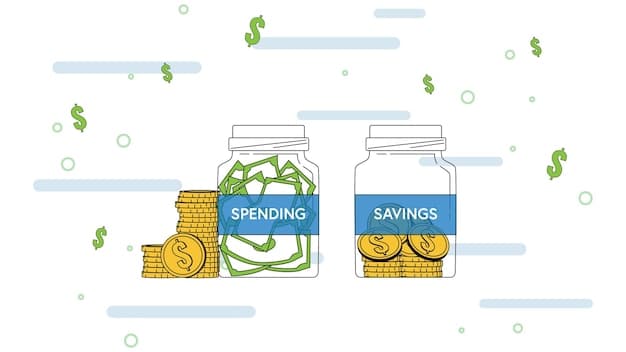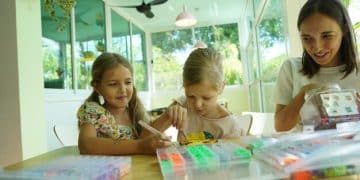Allowance Truths: Teach Kids Money Management Skills

The truth about allowance is that it’s a powerful tool to teach kids about money management, budgeting, saving, and making informed financial decisions, ultimately preparing them for a financially responsible future.
Giving your kids an allowance might seem like a simple way to teach them about money, but the truth about allowance is that it can be a powerful tool for shaping their financial future. It’s not just about handing over cash; it’s about instilling valuable lessons that will last a lifetime.
Why Give an Allowance? Unveiling the Benefits
Giving your child an allowance isn’t just about providing pocket money. It’s an investment in their future financial literacy. An allowance provides a tangible way for kids to learn about the value of money and how to manage it responsibly.
Learning Through Experience
One of the most significant benefits of an allowance is that it allows children to learn through experience. They get to make their own decisions about how to spend, save, or even donate their money. This hands-on approach can be far more effective than simply telling them about financial concepts.
Developing Financial Independence
An allowance can also help kids develop a sense of financial independence. When they have their own money to manage, they start to understand the connection between earning, saving, and spending. This can empower them to make better choices and cultivate responsibility.
- Understanding the concept of earning and saving.
- Learning to prioritize needs over wants.
- Developing decision-making skills related to purchases.
- Experiencing the consequences of their financial choices.
In essence, an allowance is a practice ground for the real world. It gives children a safe space to experiment with money, make mistakes, and learn from them without significant consequences. It’s about equipping them with the skills and confidence they need to navigate the complexities of personal finance later in life. By giving them this early exposure, you’re setting them up for a future of financial success.
Allowance Amounts: Finding the Right Fit
Deciding how much allowance to give is a crucial part of the process. The right amount will depend on several factors, including a child’s age, responsibilities, and family budget. There’s no one-size-fits-all solution, but some general guidelines can help.
Age-Based Guidelines
Many parents follow a guideline of giving about $1 per year of age per week. For example, a 10-year-old would receive $10 per week. This can be a good starting point, but it’s important to consider other factors as well.
Responsibilities and Chores
Another consideration is whether the allowance is tied to specific chores or responsibilities. Some parents choose to give a base allowance regardless of chores, while others link the amount to the completion of certain tasks. This can further reinforce the connection between work and reward.

- Base allowance: A fixed amount given regardless of chores.
- Chore-based allowance: Payment tied to specific tasks.
- Hybrid approach: A combination of both base and chore-based allowance.
The ideal allowance amount should give children enough money to make meaningful choices without being overwhelming. It should also be consistent and predictable, so they can learn to budget and plan accordingly. Ultimately, the goal is to help them develop a healthy relationship with money and empower them to make smart financial decisions.
Allowance and Chores: To Tie or Not to Tie?
One of the most common debates surrounding allowance is whether or not it should be tied to chores. Some parents believe that children should earn their allowance by completing specific tasks, while others feel that allowance should be given unconditionally.
Linking allowance to chores can teach children the value of hard work and responsibility. It reinforces the idea that money is earned, not simply given. However, it can also create a sense of entitlement if children start to expect payment for every task they complete.
Arguments for Tying Allowance to Chores
Chores teach responsibility, build character, and help children understand the value of hard work. When they earn their allowance, they’re more likely to appreciate it and spend it wisely.
Arguments Against Tying Allowance to Chores
Some parents believe that children should contribute to the household without expecting payment. They argue that family members should help each other out of love and duty, not for financial gain.
Ultimately, the decision of whether or not to tie allowance to chores is a personal one. There’s no right or wrong answer, but it’s important to consider your family’s values and goals. If you do choose to tie allowance to chores, be clear about which tasks are required and how much they’re worth. This will help avoid confusion and ensure that children understand the expectations.
Creating a Budget: Teaching Kids to Prioritize
Learning to create a budget is an essential life skill, and allowance provides a perfect opportunity to introduce this concept to children. A budget helps them understand where their money is going and make informed decisions about how to spend it.
Start by helping your child track their income and expenses. This can be as simple as writing down everything they earn and spend each week. Once they have a clear picture of their cash flow, they can start to prioritize their spending.

The 50/30/20 Rule
The 50/30/20 rule can be a helpful framework for budgeting. This rule suggests that 50% of income should be allocated to needs, 30% to wants, and 20% to savings and debt repayment.
Setting Financial Goals
Encourage your child to set financial goals. This could be saving up for a desired toy, contributing to a charity, or planning for a future purchase. Having a goal in mind can make budgeting more engaging and motivating.
- Tracking income and expenses
- Prioritizing needs over wants
- Setting financial goals
- Regularly reviewing and adjusting the budget
Budgeting isn’t about restricting spending; it’s about making conscious choices and aligning spending with values and goals. By teaching children how to create a budget, you’re equipping them with a powerful tool that will serve them well throughout their lives. It’s about fostering a mindset of planning, prioritizing, and making informed financial decisions.
Saving and Investing: Starting Early
Saving and investing are essential components of financial literacy, and it’s never too early to introduce these concepts to children. Allowance provides a great opportunity to teach them the power of compound interest and the importance of planning for the future.
Opening a Savings Account
Consider opening a savings account for your child. This will give them a safe place to store their money and earn interest. It can also be a valuable learning experience, as they’ll get to see how their savings grow over time.
Introducing Investing
As your child gets older, you can start to introduce them to the concept of investing. This could involve purchasing stocks, bonds, or mutual funds. Start small and explain the risks and rewards involved. There are digital platforms built to help children start investing with small amounts of money.
Saving and investing aren’t just about accumulating wealth; they’re about building financial security and achieving long-term goals. By teaching children these skills early on, you’re giving them a head start on the path to financial success. It’s about developing a mindset of delayed gratification and understanding that small, consistent savings can add up to significant amounts over time. The earlier they start, the more they will benefit from the compounding effects of their invested funds.
Talking About Money: Open Communication is Key
One of the most important things you can do to teach your children about money is to talk about it openly and honestly. Money can be a taboo subject in many families, but it’s important to break down these barriers and create a safe space for discussion.
Be honest about your own financial situation. Share your goals, challenges, and successes with your children. This will help them understand that money is a tool that can be used to achieve a variety of objectives.
Answering Questions Honestly
Be prepared to answer your child’s questions about money. They may ask about your salary, your mortgage, or the cost of groceries. Answer these questions honestly and in a way that they can understand.
Sharing Your Own Experiences
Share your own experiences with money, both good and bad. This will help your children learn from your mistakes and successes. It will also show them that money management is a lifelong learning process.
Talking about money openly and honestly can help children develop a healthy relationship with it. It can also empower them to make informed financial decisions and avoid common pitfalls. It’s about creating a culture of transparency and understanding around money. Children are more likely to develop good financial habits when they see their parents modeling responsible behavior and discussing money matters openly.
| Key Concept | Brief Description |
|---|---|
| 💰 Allowance Benefits | Teaches kids about money value and responsible management. |
| ⏰ Starting Age | Consider when kids can understand basic financial concepts. |
| 🎯 Budgeting | Helps kids prioritize spending and understand cash flow. |
| 📈 Saving & Investing | Teaches about compound interest and long-term financial security. |
[FAQ Section]
Frequently Asked Questions About Allowance
▼
The best age to start giving an allowance varies for each child, but generally between 5 and 7 years old is a good time. This age is when children start to grasp basic financial concepts.
▼
Whether or not to tie allowance to chores depends on your parenting philosophy. Tying it can teach responsibility, but some argue kids should help without expecting payment.
▼
A common guideline is $1 per year of age per week. However, consider your family’s budget and your child’s responsibilities. The amount should be enough for meaningful financial choices.
▼
Encourage saving by setting financial goals. Open a savings account and explain compound interest. Help them understand that saving is essential for future financial security.
▼
Let them experience the consequences of their spending choices. This is a valuable learning opportunity. Discuss budgeting and help them plan for more responsible spending in the future.
Conclusion
The truth about allowance is that it’s more than just giving kids money. It’s an opportunity to instill essential financial literacy skills. By teaching them about budgeting, saving, and responsible spending, you’re setting them up for a future of financial success and independence. Open communication and consistent guidance are key to making allowance a valuable learning experience for your children, preparing them for the financial realities of adulthood. Start early, be consistent, and let them learn by doing.





